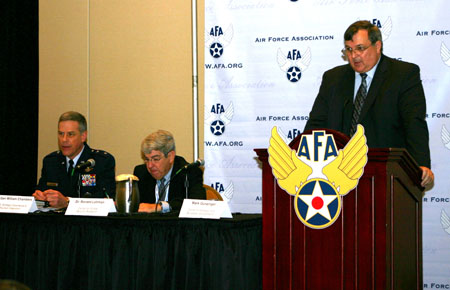As the nation weighs the future composition of its nuclear deterrent force, it’s important to remember that reductions in numbers of warheads and platforms can change the whole decision calculus of potential adversaries, Maj. Gen. William Chambers, assistant chief of staff for strategic deterrence and nuclear integration, said Tuesday at AFA’s Air & Space Conference in National Harbor, Md. “What we like to say is less is not just less; less is different,” he said. That’s why adaptation to the new security environment and maintaining “a diverse set of attributes and capabilities” remains critical “as the attributes of the force structure may become more important than sheer numbers.” For example, while ICBMs and submarine-launched ballistic missiles “will remain crucial to providing stability with nuclear peers and near peers, their high threshold may diminish their credibility in regional contingencies,” he explained. “Lack of credible capabilities, especially to provide extended deterrence against non-peers and regional actors invites instability.” That’s where nuclear-capable aircraft, such as the dual-role fighters that support NATO, come in. “Aircraft capable of deploying both gravity and standoff nuclear weapons are credible in the eyes of several potential adversaries,” said Chambers. In the future, too, Chambers said bombers may “carry an increasing role in extended deterrence.”
to remember that reductions in numbers of warheads and platforms can change the whole decision calculus of potential adversaries, Maj. Gen. William Chambers, assistant chief of staff for strategic deterrence and nuclear integration, said Tuesday at AFA’s Air & Space Conference in National Harbor, Md. “What we like to say is less is not just less; less is different,” he said. That’s why adaptation to the new security environment and maintaining “a diverse set of attributes and capabilities” remains critical “as the attributes of the force structure may become more important than sheer numbers.” For example, while ICBMs and submarine-launched ballistic missiles “will remain crucial to providing stability with nuclear peers and near peers, their high threshold may diminish their credibility in regional contingencies,” he explained. “Lack of credible capabilities, especially to provide extended deterrence against non-peers and regional actors invites instability.” That’s where nuclear-capable aircraft, such as the dual-role fighters that support NATO, come in. “Aircraft capable of deploying both gravity and standoff nuclear weapons are credible in the eyes of several potential adversaries,” said Chambers. In the future, too, Chambers said bombers may “carry an increasing role in extended deterrence.”
The U.S. sent Air Force F-16s over central Syria in a show of force following the Dec. 13 killing of two U.S. Army Soldiers and one American civilian interpreter by a gunman linked to the Islamic State group.

